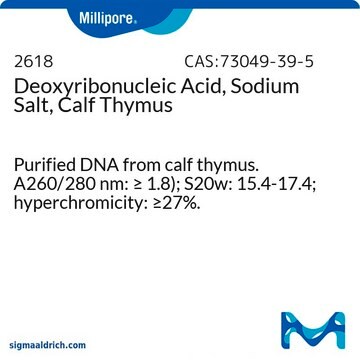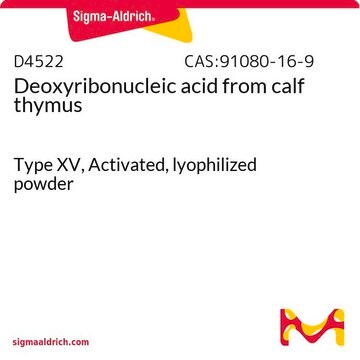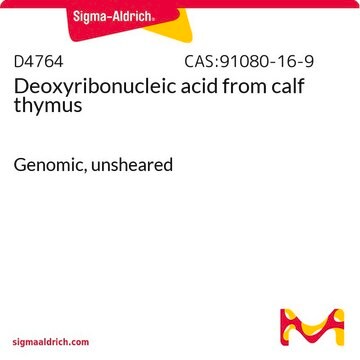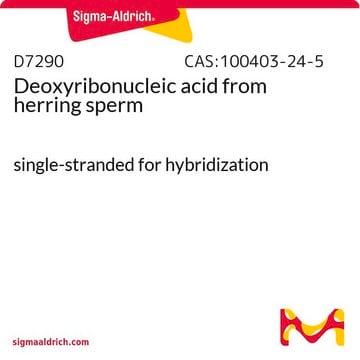D3664
Deoxyribonucleic acid sodium salt from calf thymus
suitable for substrate for DNase (Readily soluble)
Synonym(s):
CT-DNA, calf thymus DNA, DNA sodium salt from calf thymus, Thymonucleic acid sodium salt
Sign Into View Organizational & Contract Pricing
All Photos(1)
About This Item
Recommended Products
form
powder or crystals
suitability
suitable for substrate for DNase (Readily soluble)
storage temp.
2-8°C
Looking for similar products? Visit Product Comparison Guide
Application
Calf thymus DNA (CT-DNA) is a natural DNA widely used in studies of DNA binding anticancer agents and DNA binding agents that modulate DNA structure and function. Calf thymus DNA is also used in physicochemical studies of DNA behavior in solution.
Packaging
Preweighed vials prepared from D1501
related product
Product No.
Description
Pricing
Storage Class Code
11 - Combustible Solids
WGK
WGK 3
Flash Point(F)
Not applicable
Flash Point(C)
Not applicable
Personal Protective Equipment
dust mask type N95 (US), Eyeshields, Gloves
Choose from one of the most recent versions:
Certificates of Analysis (COA)
Lot/Batch Number
Don't see the Right Version?
If you require a particular version, you can look up a specific certificate by the Lot or Batch number.
Already Own This Product?
Find documentation for the products that you have recently purchased in the Document Library.
Customers Also Viewed
The Escherichia coli alkA Gene Is Activated to Alleviate Mutagenesis by an Oxidized Deoxynucleoside.
Kristin Grøsvik et al.
Frontiers in microbiology, 11, 263-263 (2020-03-12)
The cellular methyl donor S-adenosylmethionine (SAM) and other endo/exogenous agents methylate DNA bases non-enzymatically into products interfering with replication and transcription. An important product is 3-methyladenine (m3A), which in Escherichia coli is removed by m3A-DNA glycosylase I (Tag) and II
Abdollah Zakeri Siavashani et al.
Biomaterials science, 8(1), 148-162 (2019-10-31)
Implantation of temporary and permanent biomaterials in the body leads to a foreign body reaction (FBR), which may adversely affect tissue repair processes and functional integration of the biomaterial. However, modulation of the inflammatory response towards biomaterials can potentially enable
Xingyi Chen et al.
Molecular pharmaceutics, 16(6), 2690-2699 (2019-05-01)
The nucleotide-binding domain and leucine-rich repeat-containing family, pyrin domain-containing 3 (NLRP3) inflammasome is a key regulator of innate immune responses, and its aberrant activation is implicated in the pathogenesis of many diseases such as Alzheimer's disease and type 2 diabetes.
Coordination ability and biological activity of a naringenin thiosemicarbazone.
Katarzyna Brodowska et al.
Journal of inorganic biochemistry, 165, 36-48 (2016-10-21)
Farhad Ahmadi et al.
DNA and cell biology, 31(2), 259-268 (2011-08-25)
In this work, multispectroscopic atomic force microscopy and molecular modeling [ONIOM 2(B3LYP/6-31++G(d,p): Universal Force Field (UFF)) level] techniques were used to study the interaction between Calf-Thymus-DNA (CT-DNA) and pyriproxyfen (PYR) insecticide. The binding constant of PYR with double-strand deoxyribonucleic acid
Our team of scientists has experience in all areas of research including Life Science, Material Science, Chemical Synthesis, Chromatography, Analytical and many others.
Contact Technical Service












